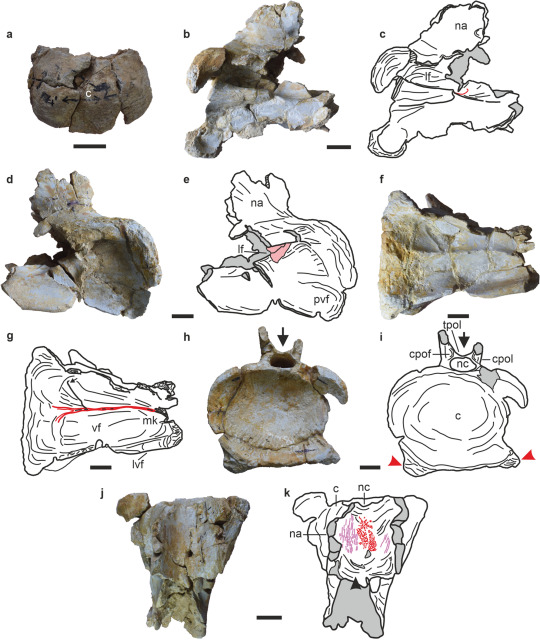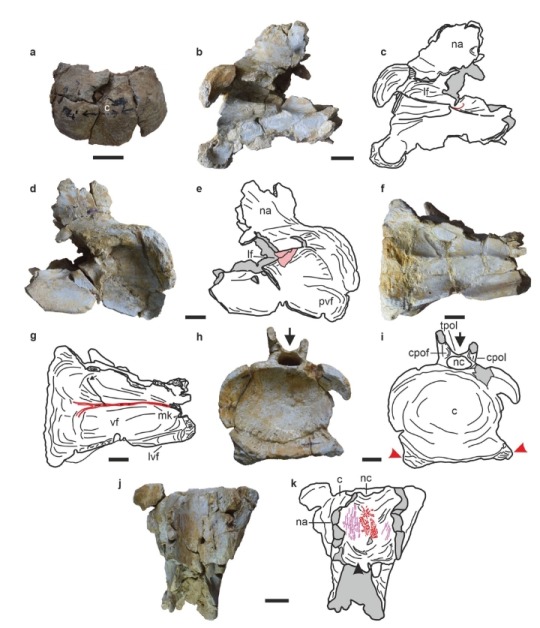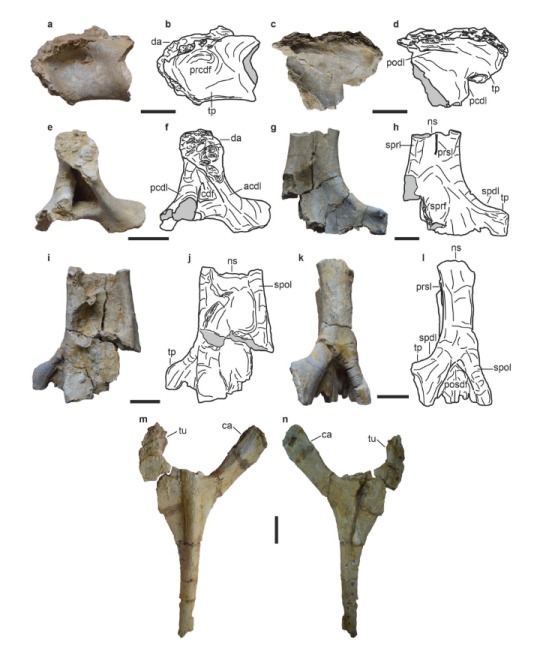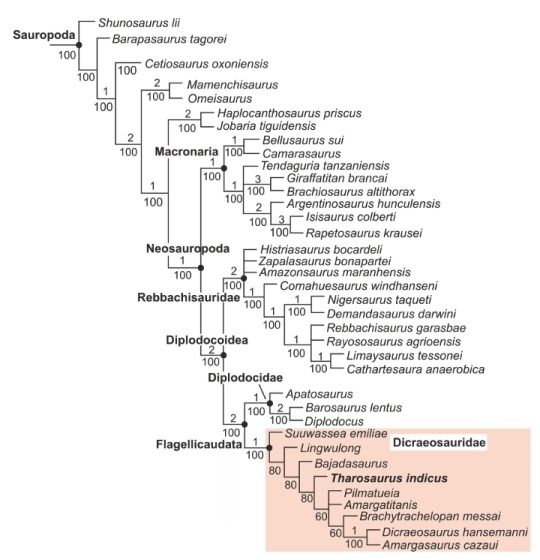#Diplodocoid
Explore tagged Tumblr posts
Note
trick or treat!!!

Barosaurus!
94 notes
·
View notes
Text
Lingwulong

Lingwulong is a dicraeosaurid sauropod dinosaur from the Middle Jurassic of what is now China. It is the earliest-aged neosauropod ever discovered, as well as the only definite diplodocoid from east Asia. Unique traits that distinguish Lingwulong from other diplodocoids include highly elaborated ornamentation along the upper margin of the orbital area and anterior dorsal vertebrae. Unlike most other diplodocoids, which have square-shaped snouts in dorsal view, Lingwulong had a U-shaped snout. Lingwulong could grow to around 20 m in length.
65 notes
·
View notes
Text

Day 17 - Tharosaurus indicus, the earliest diplodocoid discovered in history, from the Middle Jurassic
217 notes
·
View notes
Text

This newly-discovered sauropod was the oldest Dicraeosaurid and Diplodocid that has ever lived, hailing from the mid-Jurassic of what is Jaisalmer Formation of Rajastan, India, 168-165 million years ago
172 notes
·
View notes
Text

[ Fossilised caudal vertebrae of Tharosaurus indicus. ]
"A team of researchers from India has discovered fossils of a new dicraeosaurid from the Indian city of Jaisalmer in western India. These fossils, dating back to 167 million years, include bones separated at the joints but associated with specimens of the central body bones spread over an area of 270 square feet ( 25- square meters). The dicraeosaurid, called Tharosaurus Indicus in reference to the Thar desert where the fossils were found, is the first ever discovered in India and the oldest in the world’s fossil record. "The significance of this discovery rests in its antiquity," said Sunil Bajpai, a vertebrate paleontologist at the Indian Institute of Technology Roorkee and an author of the study, in an interview with Economic Times. The team of five began their work in 2018 when they discovered these fossils. The team acknowledged that the material in their possession is fragmentary, and there is a possibility that as more evidence is recovered, there might be a change in their taxonomic attribution; the fact remains that Tharosaurus Indicus currently is the oldest known diplodocoid. “...the discovery of Tharosaurus makes India a major center for not only diplodocoid but neosauropod radiation,” said the authors in the study. The discovery of Tharosaurus suggests that India played a significant role in the emergence and diversification of neosauropods, a group of long-necked vegetarian dinosaurs that thrived as the largest land animals, explained Debajit Datta, co-author of the study, in an interview with The New York Times."
Read more: "Fossils of 167-million-year-old dinosaur are the oldest of its kind" by Sejal Sharma.
#palaeoblr#Tharosaurus#Tharosaurus indicus#Palaeontology#Paleontology#India#Sauropod#Dinosaur#Mesozoic#Cretaceous#Extinct#Prehistoric#Fossils#Article
92 notes
·
View notes
Text
Tharosaurus indicus Bajpai et al., 2023 (new genus and species)

(Neck vertebrae of Tharosaurus indicus [scale bars = 50 mm], from Bajpai et al., 2023)
Meaning of name: Tharosaurus = Thar Desert lizard [in Greek]; indicus = from India
Age: Middle Jurassic (Bathonian)
Where found: Jaisalmer Formation, Rajasthan, India
How much is known: Several partial vertebrae and a rib.
Notes: Tharosaurus was a sauropod. Although it is known from fragmentary remains, the describers of Tharosaurus found it to be a diplodocoid sauropod in their analyses, which would make it a member of the lineage more closely related to Diplodocus and Apatosaurus than to Brachiosaurus. More specifically, it may have been a dicraeosaurid, a group of diplodocoids probably best known for including the bizarre Amargasaurus and Bajadasaurus from the Cretaceous of South America. If this classification turns out to be accurate, Tharosaurus would be the oldest known diplodocoid, and may suggest that the Indian subcontinent was an important region for their early evolution.
Reference: Bajpai, S., D. Datta, P. Pandey, T. Ghosh, K. Kumar, and D. Bhattacharya. 2023. Fossils of the oldest diplodocoid dinosaur suggest India was a major centre for neosauropod radiation. Scientific Reports 13: 12680. doi: 10.1038/s41598-023-39759-2
44 notes
·
View notes
Text

A dinosaur tooth of an indeterminate sauropod, possibly a diplodocoid from the Isalo III Formation in Ambondromamy, Madagascar. Although likely undiagnostic beyond Diplodocoidea at most, the morphology is similar to those seen in dicraeosaurid teeth from other deposits such as Dicraeosaurus itself. It's unknown if any of these dicraeosaurid sauropods could have been present in the Middle Jurassic deposits of Madagascar.
#dinosaur#fossils#paleontology#palaeontology#paleo#palaeo#diplodocoidea#dicraeosauridae#sauropod#jurassic#mesozoic#prehistoric#science#paleoblr#ディプロドクス上科#ディクラエオサウルス科#恐竜#化石#古生物学
13 notes
·
View notes
Text
Fossils of the oldest diplodocoid dinosaur suggest India was a major centre for neosauropod radiation
Published 4th August 2023
A new sauropod, Tharosaurus indicus, from the Middle Jurassic of the Jaisalmer Basin in western India is described based on partial remains.

Cervical vertebrae of Tharosaurus indicus

Dorsal vertebrae of Tharosaurus indicus

Phylogenetic analysis of Tharosaurus indicus
Source:
6 notes
·
View notes
Text
Yknow those moments where you like it's a weird part of day like super early morning or late at night and then you remember an interest you have and you for some god forsaken reason search too much about it! It can be an old fucking show or something just really neat!
Anyway at 7 am in the morning so far, I have learned that last year a new dinosaur was discovered called Tharosaurus!
It is the earliest known Dicreaosaurid and the oldest known Diplodocoid!!!!
It lived during the Jurassic period

In other news I have also learned that according to recent studies (Literally the Wikipedia article I read), Amargasaurus's spines were covered from top to bottom in a sail!!!! Which I am happy about!
#dinosaur#india#amargasaurus#Tharosaurus#niche#early morning#random thoughts#went Wikipedia article diving
1 note
·
View note
Note
trick r treat!! 🦉🦉

Brachytrachelopan!
34 notes
·
View notes
Text
Tharosaurus

Tharosaurus is a dicraeosaurid sauropod from the Middle Jurassic of India. It is the earliest diplodocoid currently known, and the first described from India. The fossil specimen, which consists of several vertebrae and a single rib, indicates Tharosaurus was an early-diverging dicraeosaurid, suggesting it represents a relic of a lineage that evolved in India and later spread across the world. Dicraeosaurids are advanced sauropods characterized by relatively small body size, short necks, and long neural spines. They were herbivorous and primarily browsed close to the ground or at mid-height, due to the shape of their necks and skulls.
Get a sneak-peek at upcoming dinos and request your favorite!
99 notes
·
View notes
Text
RT - Identity of India’s oldest dinosaur revealed:
Rajasthan #Dinosaur #Jurassic #Sauropod #Dicraeosaurid #Diplodocoid #Paleontology
0 notes
Text

Asperdorsus
El Asperdorsus bellator, un diplodocoide acorazado y con púas de las selvas de Skull Island. Mide 100-120 pies de largo.
Primos lejanos del Baxterisaurus de constitución más fuerte, son altos y de cuello ágil. Apegándose a las regiones espesas y boscosas, los Asperdorsus son buscadores de follaje de nivel medio que está fuera del alcance de la mayoría de los herbívoros terrestres de la jungla. Su estrecho calado permite a estos gigantes maniobrar hábilmente entre los árboles retorcidos y densamente poblados, a pesar de su gran tamaño. Los Asperdorsus tienen un excelente sentido del olfato, que los guía hacia su comida favorita en la oscuridad implacable bajo el dosel de la jungla. Sus pequeñas cabezas están talladas con dientes para cortar y rechinar. El Asperdorsus tiene predilección por varias frutas pequeñas que maduran en diferentes épocas del año, por lo que su migración lenta y serpenteante a través del bosque sigue un ritmo anual dictado por las épocas de fructificación.
Los osteodermos duros se clavan en las pieles ásperas de un Asperdorsus, y sus rígidas espinas dorsales son lo suficientemente duras como para empalar a los enemigos torpes. La armadura gruesa y su gran masa los coloca fuera de la clase de peso de la mayoría de los depredadores, aunque Venatosaurus y Carvers son un juego. Ambos depredadores están lo suficientemente armados y lo suficientemente astutos para intentarlo. Incluso estos peligrosos asesinos desconfían de la larga cola de un Asperdorsus, que es capaz de romper huesos con un golpe lo suficientemente poderoso.
0 notes
Text
"Hi, look at this diplodocoid. I need it to look badass"
Assignment understood and accomplished
FAST SWERVE. Reblog this post with your favorite dinosaur and get judged for it. BENEVONTLY
88 notes
·
View notes
Photo

Image from Wikipedia, drawn by Dmitry Bogdanov
D is for Dicraeosaurus!
Dicraeosaurus is a short-necked sauropod from Tanzania! Though related to some of the dinosaurs with the longest necks like Diplodocus and Supersaurus, Dicraeosaurus had a short neck which let it feed on middle level plants. It also had a big head to help it get more food!
#dicraeosaurus#dinosaur#palaeoblr#sauropod#diplodocoid#dicraeosaurid#sauropodiform#sauropodomorph#jurassic#late jurassic#kimmeridgian#mesozoic#africa#extinct#Dinosaur Alphabet#reconstruction
8 notes
·
View notes
Note
probably a stupid question but were there sauropods with short necks? cause it'd be funny given they're known in laymans terms as "longnecks"
Yep! Meet Brachytrachelopan mesai, a small diplodocoid and owner of the shortest neck of any sauropod!

Image ID: Digital illustration of Brachytrachelopan, a short-necked dicraeosaurid sauropod dinosaur. It is drawn here facing to the left, with its neck curved downwards and its long tail bent around behind its body. It has spines along its back and tail, and the top of its neck has speculative fleshy wattles like a rooster’s comb. Its body is a warm brown, with a pale belly and front legs. The brown fades to earthy red on the short neck, which is also covered with white and dark grey spots. The back half of the animal is dark brown with vertical white stripes. End ID.
Granted, it's still a bit longer than your average neck but it's pretty stumpy! diplodocoids, the family of dinosaur with some of the longest necks of any dinosaur (such as Barosaurus and Supersaurus), also contained two groups that were much more lacking in the neck department!
One was dicraeosauridae, which Brachytrachelopan belonged to. While other dicraeosaurids weren't quite as short-necked, some members of the group like Lingwulong shenqi were pretty close!

Image ID: Digital illustration of Lingwulong, a short-necked dicraeosaurid sauropod. It is facing to the right, with is tail curved behind its body and its neck in an upright alert posture. One front foot is raised off the ground. Its body is mainly dark grey, with light grey dapples on top and olive-green spots and stripes on its side and legs. The underside of the neck is striped with yellow, and the tail tip is bright red. There is a row of spines along its back, and a collar of yellow speculative feature spines around the base of the neck.
The other group is the Rebbachisauridae, a poorly-known group that contains Nigersaurus taqueti, one of the weirder sauropods out there. And that’s saying something in a list of long-necks with short necks. Not only did Nigersaurus have a relatively short neck, it also had a very wide "vacuum cleaner" mouth filled with tiny teeth!

Image ID: Digital illustration of the rebbachisaurid sauropod dinosaur Nigersaurus. It is facing the left, with one front foot off the ground and its head turned towards the viewer. The neck is angled gently upwards in a neutral pose. The body is dull green with slightly darker spots and stripes. The stripes fade to brown on the neck, accented with white spots. The face is a dull pink, as are the speculative fleshy wattles underneath the base of the neck.
#dinosaurs#paleoart#paleontology#my art#palaeoblr#sauropods#brachytrachelopan#lingwulong#nigersaurus#prehistoric#jurassic#cretaceous
479 notes
·
View notes